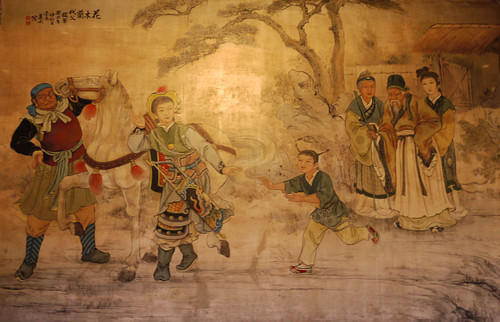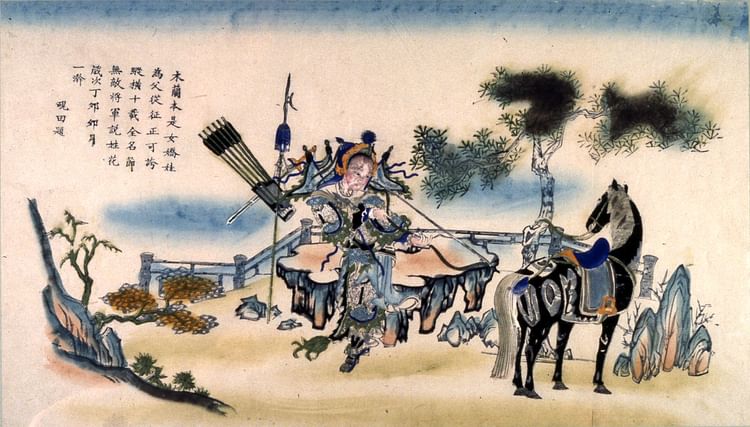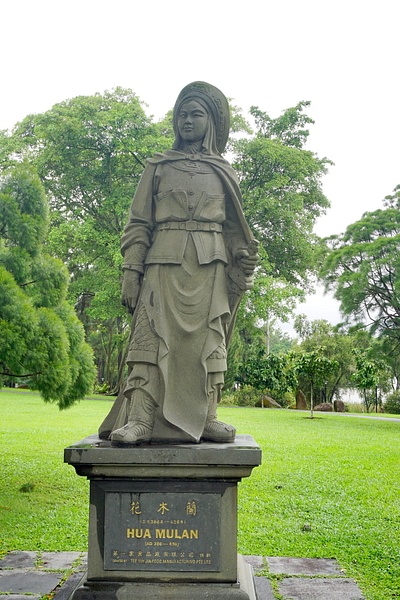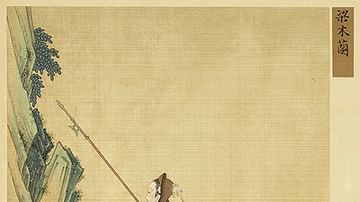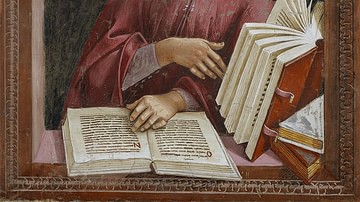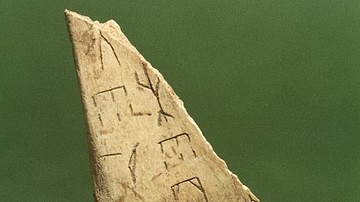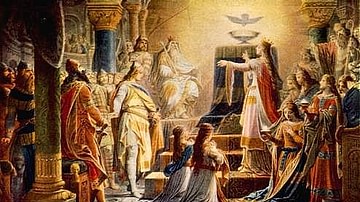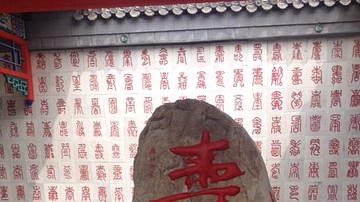Mulan (“magnolia”) is a legendary character in Chinese literature who is best known in the modern day from the Disney filmed adaptations (1998, 2020). Her story, however, about a young girl who takes her father's place in the army to help save her country, is hundreds of years old
The tale most likely originated in the Northern Wei Period (386-535 CE) of China before it was developed by succeeding authors. Scholarly consensus is that Mulan is a fictional character, probably developed in Northern China in response to the greater independence women enjoyed there, whose legend was then revised in succeeding eras to reflect the values and challenges of the times.
The original work, The Poem of Mulan, dates to the 6th century CE and reflects the influences of Mongolian-Turkic peoples on the region with a focus on filial piety the central virtue and moral of the tale. The later Song of Mulan (from the Tang Dynasty, 618-907 CE) retains this theme while changing the time period and focus. The legend was later included in a compilation by one Guo Maoqian of the Song Dynasty (960-1279 CE), which provided other writers with the source material for their versions.
The play The Female Mulan (16th century CE) modifies earlier themes, moves the action back to the time of the Northern Wei, and introduces the happy ending of the marriage motif while succeeding versions conclude with Mulan killing herself to avoid the shame of having to become the emperor's concubine until the story returned the conclusion of the joyful family reunion and marriage. By the time the character reached the modern era, through the film Mulan Joins the Army (1939), she was a staunch nationalist, driving out foreign invaders, and her earlier virtue of filial piety had been replaced by unwavering love for her country.
Since the appearance of the 1998 Disney animated film, Mulan's story has grown in popularity and drawn attention to the other women, all historically attested, who took up arms for a cause they believed in throughout China's history. The fictional heroine has thereby brought actual heroines to light and further encouraged female empowerment, self-determination, and recognition of feminine strength, which the most recent Mulan (2020) will no doubt contribute to.
Summary & Time Period
The story, as it is best known today through the recent films, places Mulan in an unidentified era of Imperial China (221 BCE - 1912 CE), but the original poem is set during the Northern Wei Period. The modern and ancient versions follow basically the same plot of a young girl who takes her aged father's place in the army when he is called to serve, performs her duties admirably, saves her country, and returns home to her family where she is received with honor.
In the Disney films, she is revealed as a woman but perseveres against the prohibition on females serving in the army to go beyond what is expected of her in defeating China's enemies; in the original version, where she serves 12 years, her gender is never questioned, and she only reveals herself at the end, much to the surprise of the men who served with her.
The original poem takes place during the chaotic era between the fall of the Han Dynasty (202 BCE - 220 CE) and the rise of the Sui Dynasty (589-618 CE) during which China first split into the Period of the Three Kingdoms (220-280 CE) and was then ruled by succeeding short-lived dynasties, one of which was the Wei, which established itself during the period of the Northern and Southern Dynasties (386-589 CE). The Northern Wei kingdom was founded by the Toba (also given as Tuoba, Tabgach) clan of the Xianbei of Mongolia, of Turkic heritage, who adopted Chinese culture and customs just as the Chinese of the region assimilated those of the Toba. Scholar Harold M. Tanner comments:
As [the Xianbei] merged with the larger Han Chinese population, these non-Han people changed Chinese culture. The changes were especially noticeable in the north, where the blending of Turkic and Chinese elites over time produced a new aristocratic society…Central Asian musical instruments, notably the pipa (a lute-like plucked stringed instrument) and the huqin (a two-stringed fiddle) entered the mainstream of Chinese musical culture. Northern music and poetry absorbed the cadences of Central Asian folk music, and northern women were more independent and played a greater role in public than their sisters in the south. An unknown poet of the fifth or sixth century celebrated, or perhaps exaggerated, this female independence in the “Song of Mulan”, which later writers expanded into a play and, ultimately, a Disney movie. (162-163)
Tanner here mistakes “Song of Mulan” for “Poem of Mulan” which is set against the backdrop of a Rouran invasion of Northern Wei. The Rourans were a nomadic people to the west who mounted repeated invasions of China over the centuries which, to guard against, the Northern Wei had added to and expanded upon the existing line of the Great Wall of China.
The poem begins with Mulan sitting at her loom, weaving and sighing, and when asked who she is in love with that is causing such sighs, she explains that she has seen the summons from the government, how the Khan is mobilizing the troops, and how her father's name is on the list of conscripts. Her younger brother is only a baby and her father is too old to serve and so she tells her family that she will take his place as she is already well versed in martial arts, horsemanship, and archery. No one objects and so she buys a horse and equipment and goes off to war.
She serves with distinction and is offered the honor of an important governmental position but refuses it. She returns home with her fellow soldiers, goes indoors, and changes back into feminine attire. When she comes back out, her comrades say, “We marched together for these twelve long years/And absolutely had no clue that Mulan was a girl!” (Shiamin, Idema, xiv). The poem ends with the narrator comparing people to hares and how, when they run side by side, no one can tell male from female, and so it is with people as well.
The later Song of Mulan from the Tang Dynasty changes the locale to Tang-era China and focuses on the danger to the state posed by recent rebellions such as the An Lushan (766-779 CE). The story is the same but there is greater emphasis laid on service to the state through the Confucian ideal of filial piety. The original motivation for Mulan's service is still to save her father but salvation of the family member is equated with defense of the country. This, of course, is in keeping with Confucian ideals in that a virtuous family, theoretically, will help produce a virtuous community and, by extension, a nation.
The Female Mulan & Succeeding Versions
During the Song Dynasty, the anthologist Guo Maoqian completed his Collected Works of the Music Bureau which included documents from the work known as Musical Records Old and New from the 6th century CE, including the Mulan legend. There are no known versions of the Mulan story between the Tang Dynasty and the play The Female Mulan by the playwright Xu Wei (l. 1521-1593 CE) so it is assumed that Xu Wei drew on Guo Maoqian's work for his own. Xu Wei introduces the character's surname Hua (“flower”) to Mulan as well as her assumed name as a male, Hua Hu, details her transformation from a girl to a male warrior, and concludes with the marriage motif which was popular in his time.
The play is set in the Northern Wei period when men are being conscripted to fight against a notorious rebel-bandit leader who calls himself Leopard Skin. The author's choice of this time period and this threat is intentional to appeal to the historically literate of his audience since, in 386 CE in Northern Wei, there was unrest caused by rebels and bandits of the south and the Kingdom of Northern Wei did actually issue a call to arms and conscription.
The play is written in two acts with the first detailing her decision to go to war and the second following her through battle and her return home. In the first act, she explains her situation, goes out and buys equipment, and then unbinds her feet (a practice which was unknown in the actual Northern Wei Period but would have been familiar to Xu Wei's audience) as the most telling detail of her transformation from female to male. She practices with her weapons and then joins the soldiers to ferret out Leopard Skin and his men. Act II opens with the attack on Leopard Skin's lair, his capture by Hua Hu (Mulan), and the honors the young soldier then receives from “his” commanding officer. Shiamin and Idema describe what follows:
Hua Hu is singled out for his part in the capture and is given a cap and girdle as symbols of a promotion to a position in the Imperial Secretariat. Hua Hu is thus sent home, still as a man, in the company of her two fellow soldiers, to await the new appointment…As she travels with the soldiers, they comment on how strange it is that they have never seen Hua Hu use the toilet [Hua Hu responds with an allusion to the moon goddess whose face frequently changes and true self is unknown]…Returning home, Hua Hu first reapplies female makeup, then greets her family. She shares her successes with her parents, showing them the cap and girdle she has been granted, and then confirms that she returns to them a “dogwood bud”, or virgin. After her amazed fellow soldiers leave, a young male lead, also wearing cap and girdle enters…The two have been conveniently matched by their parents and are immediately married on stage. (xviii)
The success of Xu Wei's play encouraged other versions of the Mulan legend during the Qing Dynasty (1644-1912 CE). The Historical Romance of the Sui and Tang, composed using earlier sources by Chu Renhuo (l. c. 1630 - c. 1705 CE), was extremely popular and recast the legend during the period of the decline of the Sui Dynasty when the Eastern Turks supported rebellions against the Chinese government. In this version, Mulan is the daughter of a Turkish father and Chinese mother and, when the Turkish khan conscripts her father, Mulan goes in his place.
She is captured by a female warrior, Dou Xianniang, who admires her courage and employs her as an assistant, saving her life and associating her with the winning side. When the war is over, Mulan is pardoned and returns home to find that her father has died. The Khan, having taken notice of her during the conflict, sends word that she is to join his harem and, rather than submit to this shame, Mulan kills herself.
This same story is told, with significant differences, in The Story of the Loyal, Filial, and Heroic Mulan (also known as The Complete Account of Extraordinary Mulan, c. 1800 CE). In this version, Mulan's grandfather, Zhu Ruoxu, is a master of dark arts which he has learned from a greater master, Li Jing. Zhu Ruoxu refuses to use the powers himself but teaches them to Mulan. Years later, war is declared and Mulan's father is conscripted but she goes in his place, proves herself a master of all martial arts, and is accepted into the army. Li Jing, who is supervising recruits, recognizes her but keeps her identity a secret. She is swiftly promoted to the position of general under the name Wu Zhao. She has many adventures in which her mastery of the dark arts plays a part, including a difficult ascent up a mountain to deliver a message to a monk who gives her a magical camel.
She later uses the camel to help defeat the opposing army's general. Offered a lofty position of honor by the Tang Emperor Taizong, Mulan reveals herself as a woman who cannot serve in the post. Instead of punishment, the emperor changes her title to Princess Wu Zhao and allows her to return home. The emperor changes his mind afterwards, however, and demands that she return. Mulan refuses three times, knowing that the emperor has listened to lies about her plotting against him and plans to execute her; to prove her innocence and virtue, she kills herself.
Modern-day Mulan
According to Shiamin and Idema, an opera Mu Lan Joins the Army was written in 1903 CE which sets the action in the Han Dynasty with the Xiongnu (a tribe of warriors often associated with the Huns) serving as the antagonists. The story follows the same basic plot as earlier versions, but the focus is on the cowardice of men and strength of women. Shiamin and Idema note:
Mu Lan eagerly jumps at the opportunity to join the army once her cousin, despite his devotion to the martial arts, turns out to be too much of a coward to do his duty. Her primary motivation now is not filial piety but “to shame those men” and to serve as a model for women. (xxiv)
The play does not seem to have been produced but, by this time, the legend of Mulan was well known throughout China and inspired many women to emulate her. Her influence inspired the female freedom fighter, intellectual, and poet Qiu Jin (l. 1875-1907 CE) in her efforts to overthrow the corrupt Qing Dynasty. Qiu Jin was arrested and executed but her actions inspired other women to follow her example.
The Mulan legend was first featured on film in China in 1939 in Mulan Joins the Army which presented her as an ardent nationalist whose zeal for her country and heroism shames her male comrades throughout her tour of duty. After serving honorably, she returns home, reveals to her closest comrade that she is a woman, and the two are married.
Mulan was featured, or alluded to, in other Chinese films afterwards but received international attention in 1998 with Disney's release of the animated feature film Mulan. This version tells the same story but with typically Disney additions of a comical talking dragon, sentient cricket, and seemingly self-aware horse and retains the happy ending of the reunion of Mulan with her father and family and the suggestion that she will marry the handsome commander she served with. The film was generally well-received though Turkish Nationalists condemned the portrayal of the Hun invaders as savage barbarians and the Chinese government objected to the talking dragon which they felt mocked the traditional grandeur of the iconic Chinese symbol. Even so, the film introduced the Mulan legend to a wider audience and inspired greater interest in Chinese history and literature.
Conclusion
The most recent Mulan (2020), incorporates a number of motifs and characters to tell the story for a new generation. An early scene in which Mulan is out riding and notices two hares running side-by-side is a direct allusion to the earliest version of the legend when the narrator points out that no one notices the difference in gender when hares run next to each other. The warrior woman Dou Xianniang also appears, combined with the “dark arts” aspect of The Story of the Loyal, Filial, and Heroic Mulan, to create an engaging character and the film works, drawing on many other aspects of the legend, to provide an audience with a new vision of the story instead of a simple remake of an earlier successful film. This latest version, not released in theaters but streamed by Disney-Plus in those countries which carry it, has received mostly positive reviews and has already revived significant interest in the legend.
Mulan's popularity since 1998 has generated interest in historical Chinese heroines who were previously unknown in the West and the latest film will no doubt do the same. Among these women is Xun Guan of the Western Jin Dynasty (265-316 CE), the 13-year-old daughter of governor Xun Song, who led a hand-picked team of soldiers to break the lines of the enemy forces surrounding her father's city and brought back a relief force to lift the siege. Princess Pingyang of the Tang Dynasty trained her own military (known as The Army of Lady Li) and led them in a number of victorious engagements against the forces of the then-corrupt Sui Dynasty. She is the only woman in the history of Imperial China to receive military honors at her burial. The warrior woman Wong Cong'er (l. c. 1777-1798 CE) commanded the White Lotus Sect in the rebellion against the Qing Dynasty, leading an army of men and using guerilla tactics to achieve a number of significant victories. Finally surrounded and facing defeat, she leaped from a cliff rather than submit to capture.
Mulan's story, and name, were also influential in the establishment of the martial art of Mulan Quan (also Mulan Hua Ja Quan) which combines tai chi with dance, Kung Fu, and other arts to create a unique form of self-defense and personal improvement. The discipline is intended to encourage the confidence, strength, and grace of Mulan in modern-day practitioners and is only one of the many examples of how the legend of Mulan continues to inspire people today, especially women, just as it has done in the past.
